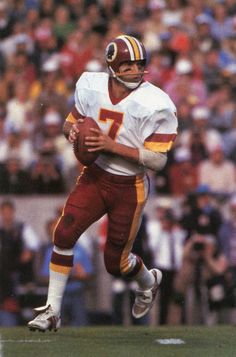 Yesterday, we looked at the teams that overachieved their projected wins total by the largest amount based on the strength of their offensive and defensive passing games. Today, the reverse: the biggest underachievers. And that starts in Washington, D.C., the year before Joe Gibbs arrived.
Yesterday, we looked at the teams that overachieved their projected wins total by the largest amount based on the strength of their offensive and defensive passing games. Today, the reverse: the biggest underachievers. And that starts in Washington, D.C., the year before Joe Gibbs arrived.
The head coach was Jack Pardee, who was in Washington for three years, going 8-8 in 1978, then 10-6, and then 6-10 in 1980. Pardee was fired after the season, and you can see why: Washington didn’t just have a good pass defense in 1980, but a great one. It ranked as the 12th best pass defense from 1950 to 2013. Both corners, Lemar Parrish and Joe Lavender, made the Pro Bowl. Both safeties, Mark Murphy and Tony Peters, were in the primes of their careers, and would make a Pro Bowl under Gibbs.
Washington had an absurd 8.4% interception rate and a 9.9% sack rate, which helped the defense allow just 2.4 ANY/A, nearly a full yard better than any other team and 2.51 ANY/A better than league average. And the team went 6-10! The offense had Joe Theismann, Art Monk, and Wilbur Jackson; Theismann ranked 17th out of 30 qualifying passers in ANY/A, but that shouldn’t have been enough to keep the team out of the playoffs, let alone below .500.
Washington’s offense finished with a Relative ANY/A of -0.33, and its defense had a RANY/A of +2.51. The team had a 0.375 winning percentage, but “should” have had a 0.704 winning percentage. That means the team underperformed by 5.3 wins, the most of any team in the Super Bowl era.
Since the merger, only two teams have ever led the NFL in ANY/A allowed and finished below .500: Washington, in 1980, and Cleveland in 2001.
So why didn’t Washington win more games in 1980? Well, for starters, the run defense was really bad, ranking in the bottom five in first downs, yards per carry, and rushing yards. And while punt returner Mike Nelms made the Pro Bowl, the special teams wasn’t all good: a year before winning the AP MVP, Mark Moseley went just 18 of 33, although 8 of those misses were from 50+ yards. Meanwhile, opponents hit 13 of 17 field goals.
A 2-4 record in close games didn’t help things, and a -6 fumbles lost differential hurt, too.
But in the end, Washington just wasn’t very good at much other than stopping the pass. If the defense didn’t force turnovers, the team was toast. Washington went 0-8 in games where it had two or fewer takeaways, and 6-2 in games with 3+ takeaways. That included a 10-punt game against Dallas, when Washington lost despite winning the turnover battle 6-2.
